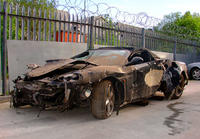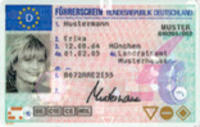To buy a car in Italy with an Italian registration plate , you must be registered as a local resident and will require a document (e.g.ID card), permesso di sorgiorno, codice fiscale and certificate of residency (which you can self-certify).

Unless you know a lot about cars it is best to buy from a garage or perhaps there is someone at work who has a car for sale (though you should still get a mechanic to check it out before you buy). Check how up to date the car tax ( bollo) is as you will be responsible for paying any arrears. If you are buying the car from a dealership, they will organise the documents for the transfer of ownership. If you are buying privately, you need to go to the local office of the Automobile Club Italiano (ACI - http://www.aci.it/ ) or the office of the mottorizzazione civile with the previous owner to transfer ownership. In each case you will have to pay ownership transfer fees ( Passagio di proprietà). This transfer should be done within 10 days of buying the car.
Car tax (bollo)
Every car must be taxed even if you are not using it and keeping it off the road. Keep the receipt of payment in the car in case you are ever stopped by police. Failing to produce it will result in a fine.The tax you pay depends on whether the car is diesel or petrol and the power of the engine -measured in kilowatts (KW) or horse power ( cavalli). Your logbook ( libretto) will state what power yours is under the heading “pot max.”
You can pay your car tax in a number of places. The easiest is in a bar/ tabaccaria, but it can also be paid at the bank, office of Automobile Club Italiano – in person or on line at http://www.aci.it/ . You can even pay at the post office if you are prepared to queue. Car tax runs for a year and is due either by end December (final payment date end Jan) or end August (final payment date end Sept). The government gives a months grace to get it paid!! As almost everyone waits until the last day of January to pay it is wise to ensure that you go earlier to beat the rush! It is also a good idea to take the car logbook ( libretto) with you when you pay so that you have all relevant information to hand (bring also your codice fiscale no.).
Note: if you are taxing a brand new car (for the first time) you must pay the tax before the end of the month if you buy the car before the 21st and by the end of the following month if after that date.
MOT (revisione)
MOT or revisione is the periodic, legally required, garage check that says that your car meets some minimal safety requirements. Until recently in Italy this was required only for 10 year old cars but in line with European legislation the revisione is now a legal requirement for all cars more than 4 years old and must be carried out every 2 years after that. It can be carried out at any authorised garage who will stamp your libretto (log book) to show that the car has passed. This is frequently checked when you are pulled over at a police checkpoint.
A revisione (similar to an MOT in the UK) checks very specific criteria and is not a service. If you want a service you need to ask for “fare il tagliando” .
Car insurance
The car insurance market has recently changed significantly, with new entrants providing more choice and more services. Car insurance in Italy is still very expensive and notoriously slow to pay out so it is worth spending some time and effort getting the right coverage and price for you.

What type of insurance cover should I take out?
The key options are:
- Comprehensive ( casco). This is very expensive in Italy and for that reason is rarely bought by local Italians. Some companies are also not willing to insure cars more than 4 years old.
-
Third party ( responsabilità civile). The legal minimum is pretty low cover particularly in the case of a serious accident. You might like to think about getting higher coverage.
One could add on the options:
- fire and theft ( incendio, furto)
- infortuni dei conducente: this gives cover to the driver in the case of an accident where the driver is responsible.
- You may also decide to add the option of roadside assistance ( servizio assistenza) if you do not already have it (usually not expensive).
No claims bonus (bonus-malus rating index) has a scale from 1 (highest bonus) to 18 lowest bonus). Your personal rating will depend on age, years driving without an accident etc. Ask your insurance company at home to issue you with a very official looking certificate stating your no claims bonus and how many years of accident free/no claims driving that accounts for. The Italian insurance company may accept it (or an authenticated Italian version of it) to help establish your rating.
Once you have your car and have decided what type of insurance you wish it is worth shopping around for the best deal. Below are listed the web sites/phone numbers of some of the major players. For a comprehensive list - try a search on http://www.google.it
If you drive your car outside Italy, you need your insurance company to issue you with a green card (a sort of international insurance document).
Driving licence
In Italy, you may have a licence once you reach 18 and it is valid for 10 years (5 years if you are over 50 and 3 years if you are over 70).
Foreigners may drive using their home country driving licence for the first year of residency in Italy. After this deadline, EU citizens with the old style licences must get them authenticated or converted into Italian licences. Non-Europeans must acquire an Italian one (i.e. take a driving test). Failure to do so may mean not only fines for driving without a valid licence but more worryingly may invalidate your motor insurance in an accident.

If you have a new style credit card EU driving licence in theory you can drive without changing it. If you are from a country that has no reciprocal agreement with Italy (among those who don’t are US, Canada, Australia), you will have to sit an Italian driving test (also before the end of the first year of residency).The driving test has both a written and practical part. Note foreigners have the possibility to answer oral questions instead of taking a written exam which is generally accepted to be easier unless your Italian is excellent . You will need to register with a driving school and take a course of lessons before attempting the test.
Your Car and the law
If you are stopped by the police on one of their many occasional roadside checkpoints you must have on you:
- Driver’s document (passport or ID card)
- Driver’s driving licence (or receipt showing that it is currently in the process of conversion)
- Car tax receipt
- At least third party car insurance (displayed in car windscreen),
- Libretto or logbook with an up to date revisione if car is > 4years
- Bright yellow luminous pull on jacket (buy at any petrol station) if you have an accident or need to stop on an autostrada. You shouldn’t leave the car without putting it on
- Your dipped headlights should be used on all major roads and autostrada. As there is considerable confusion as to when you need them most Italians have their lights on all the time.
Strictly speaking the licence, ID card, and libretto should have the same (current) address and you can be fined if not. How strictly this is applied depends on the mood of the vigile stradale (traffic police) and how well you play the “poor lost foreigner” card.
By Helen Burgess, Insight Italy
Relocation and integration services
http://www.insight-italy.com/


